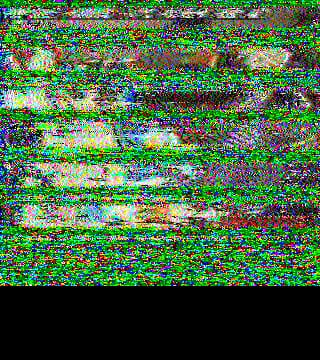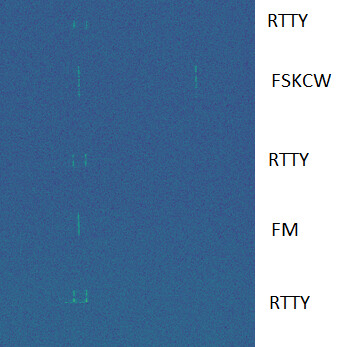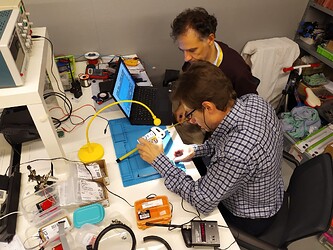@EA4SG @maria It looks like the Dwingeloo telescope managed to get URESAT, can you check the observation and confirm/verify that this is the expected transmission of URESAT?
We can confirm that this is the expected transmission of URESAT. We are now trying to decode the data packets.
@fredy Thanks for your advice!
To analyze the data, we used the MRC-100 TLE and a measurement made on June 26. On that day MRC-100 was targeted and it was deduced that URESAT-1 should be about 20-30 seconds ahead according to the packets we received. Knowing this, the following actions were taken:
- Select the satellites that on the day of the measurement were close to MRC-100.
- Collect the TLEs from those satellites.
- Propagate backward to the day of the measurement those TLEs by imposing the mass and area of URESAT-1. This propagation has been performed with General mission analysis tool (GMAT).
- Select the satellite which is separated about 20-30 seconds from MRC-100.
In addition to that, check that in real time, the object is still close to MRC-100.
It is a particular case, but I hope it helps!
Hi all:
Yes… that observation is getting signals from URESAT. The FSK frames, the CW beacon and the SSTV transmission fit with the expected TX sequence from URESAT-1
We have been able to decode partially the SSTV transmission and it is one of the pictures inside of the satellite image bank. See enclosed the received picture and the original one.
Amsat-EA will work on decoding the several telemetry frames and CW beacons received by Dwingeloo and will share the received status data.
Unfortunatly we think that the antennas have not been deployed yet, because some stations in EA had been QRV in the next pass with yagi+LNA preamp but getting no signal from the sat.
Anyway we would like to thanks PE0SAT, Satnogs staff and PI9CAM and Dwingeloo staff. They have been very patience with us but at the moment they have been able to capture the best observation of URESAT ever. THANKYOU FOR YOUR COOPERATION !!!
Check AMSAT-EA web page for updates. We will share info there and also here in this topic.
73 de David EA4SG

Thank you @maria and @EA4SG for the confirmation and the information.
By running ikhnos on this observation, it seems that the transmission is -2.4KHz off and that it follows pretty well OBJECT BU(56992), some other objects are close but unlikely to be URESAT-1.
I’ve added this drift in DB. About the identification, given that ikhnos is not very accurate as other methods and that probably there will be another one observation today or tomorrow, I’m going to wait to verify the identification.
Thanks a lot for the drift calculation Alfredos !!!
Now that Dwingeloo and all knows where to beam antennas (56992), I think that it totally worths to program more observations in PI9CAM
73s
David EA4SG
We will try to observe another pass tomorrow. I would be quite certain of this TLE identification, given that the satellite was within our 1.5 degree beam for an entire pass with this TLE.
Hi Tammo:
From your observation we get a CW beacon with the message “VVV TNX EC1CT DE AO4URE” . That message is stored in the URESAT-1.
By the way, EC1CT is one the the project donors.
Looking forward for your observation tomorrow. Thanks in advance.
David EA4SG
SSTV from Dwingeloo observation show URESAT callsign AM4URE:

Today’s URESAT observation from Dwingeloo worked fine again. No SSTV, I guess only CW. See this observation. The IQ data is here. Thanks to @cgbsat for joining me in the telescope for the observation.
Thanks for the IQ!
My guess based on listening on the signals in SDR++

edit:
Here’s a demod of the FM part, sounds like a burst of DTMF and some voice.
RTTY some 1150Hz separation:
CW: unable to upload… ?!
And with this observation we can be 100% sure that OBJECT BU(56992) is URESAT-1.
Here are the ikhnos results on the observation above.
Having a look around 220s into the observation there is a bit of clear CW, with the text ‘VV TNX EA3GHS DE AO04URE’.
Hi all,
We have published the source code for the URESAT-1 decoder, so anybody can compile it for other operating systems or make any modifications.
Thanks all, specially, Dwingeloo and Satnogs teams for all the help identifying and receiving our satellite.
73,
Félix EA4GQS
Maybe MRC-100 can now be assigned to 56993 instead of 99182. All recent recordings are perfectly matched.
According to our observations, ISTANBUL seems to have higher probability to be the object BP…
@fredy can we switch the TLE to object BP 56230 for future observations?
@bcsak I’ll change it during the weekend, sorry for the delay but I had to spend some time in SatNOGS development and operations left a little behind.
@oh2uds I’ve changed the NORAD ID we follow for ISTANBUL.
Does anyone have some update about ROM-2?
I decoded now the Morse from ROM-2 (using this observation: SatNOGS Network - Observation 7745967). It said:
AM9ROM,16.03,3.2V,0FASA0,JT0,1,0 (although there is some uncertainty in the 0FASA0 part)
Updated decoding: AM9ROM,16.03,3.2V,0.30,10,1,0
In this Morse code, the dit time is 0.03 sec, the dah is then 0.09 and the symbol space is indeed 0.03 sec. However, the letter space is not 3 but 2 dit time (i.e. not 0.09 but 0.06 sec). This allowed some sort of self-synchronization between the letters and therefore some forward error correction ![]()

